Platy fish are colorful, friendly, and easy to care for aquarium pets. Known for their bright colors, playful personalities, and peaceful nature, Platies are perfect for both beginner fish keepers and experienced aquarists. They add a lively touch to any tank without demanding much in return, making them an all time favorite in the fishkeeping community.
This guide covers Platy fish care, lifespan, diet, breeding, tank setup, and disease prevention.
Types of Platy Fish
Here are some of the most popular types of Platy fish, each with its own unique colors, patterns, and personality, making them a beautiful addition to any aquarium.
Red Wagtail Platy
Scientific Name: Xiphophorus maculatus
Diet: Eats flakes, pellets, live food, and vegetables.
Size: Grows up to 2–3 inches in an aquarium.
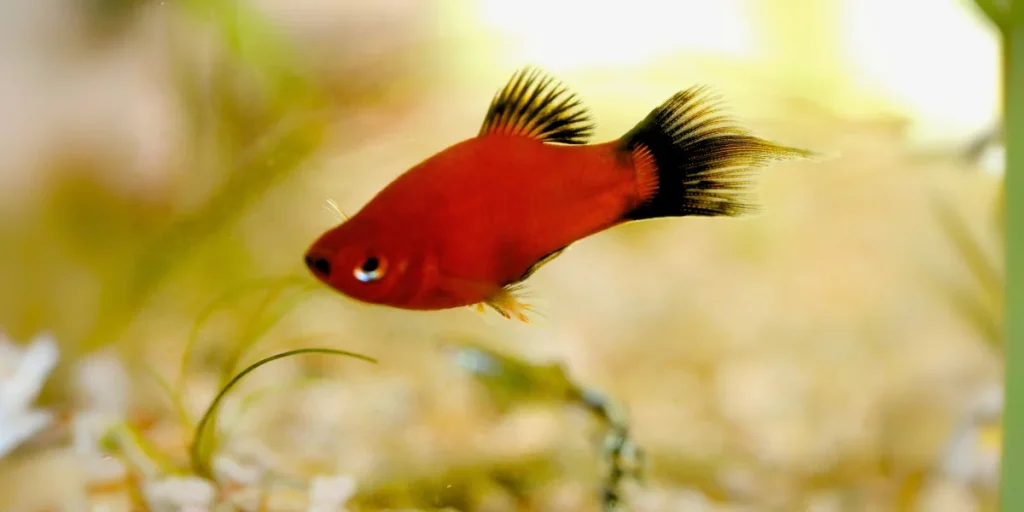
The Red Wagtail Platys is one of the most eye catching freshwater aquarium fish, admired for its vibrant red body and striking black tail. It’s a favorite among aquarium hobbyists and beginner fish keepers because it’s both beautiful and easy to care for.
These friendly and active Platies love to swim around the tank, bringing life and color to any aquarium. They thrive in community tanks with other peaceful fish species, making them perfect tank mates for guppies, mollies, and tetras. Red Wagtail Platies also enjoy tanks with live plants, where they can explore, play, and find cozy hiding spots.
With proper care, a balanced diet, and clean water, Red Wagtail Platies stay healthy and continue to flaunt their brilliant red and black colors. If you’re looking for a low maintenance, colorful, and cheerful fish to brighten your aquarium, the Red Wagtail Platy is an excellent choice.
Mickey Mouse Platy
Scientific Name: Xiphophorus maculatus
Diet: Eats flakes, pellets, live food, and vegetables.
Size: Grows up to 2–3 inches in an aquarium.

The Mickey Mouse Platy is one of the most charming and recognizable freshwater aquarium fish, loved for the tiny Mickey Mouse shaped marking near its tail. With its playful look and bright colors, this adorable fish adds instant cheer to any tank. It’s also one of the best beginner friendly fish because it’s hardy, peaceful, and easy to care for.
These active and friendly Platies love swimming around in groups and get along wonderfully with other peaceful community fish like guppies, mollies, and swordtails. They thrive in aquariums filled with plants and hiding spots, where they can explore and feel safe. Their curious nature and lively behavior make them a joy to watch every day.
With a balanced diet, clean water, and a calm environment, Mickey Mouse Platies stay healthy and keep their vibrant colors shining bright. Whether you’re new to fishkeeping or looking to add a splash of color and personality to your aquarium, this friendly little fish is sure to steal your heart.
Sunset Platy
Scientific Name: Xiphophorus maculatus
Diet: Eats flakes, pellets, live food, and vegetables.
Size: Grows up to 2–3 inches in an aquarium.
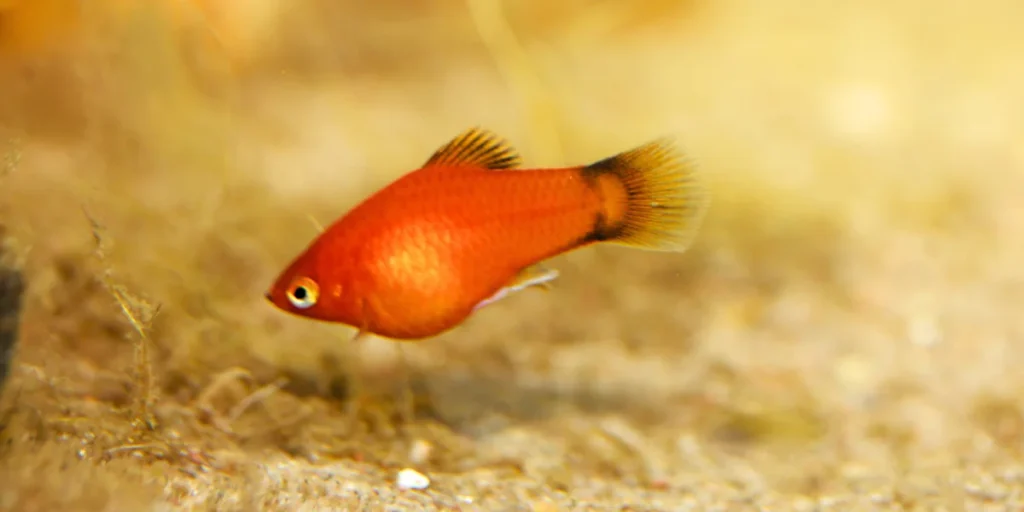
The Sunset Platy is a stunning freshwater aquarium fish that shines in shades of orange, yellow, and gold just like a glowing sunset. Its warm, radiant colors make it one of the most loved choices for beginner aquarists and anyone looking to add a splash of brightness to their tank. Easy to care for, gentle, and full of life, the Sunset Platy is a true favorite among fish enthusiasts.
These peaceful and active Platies thrive in community tanks with other friendly freshwater fish such as guppies, mollies, or tetras. They love to swim freely and explore, especially in aquariums filled with plants, rocks, and hiding spots where they can play and feel secure.
With clean water, a balanced diet, and a calm environment, Sunset Platies stay healthy and continue to show off their dazzling colors every day. Whether you’re new to fishkeeping or adding to your collection, this cheerful little fish will light up your aquarium with warmth and beauty.
Blue Platy
Scientific Name: Xiphophorus maculatus
Diet: Eats flakes, pellets, live food, and vegetables.
Size: Grows up to 2–3 inches in an aquarium.

The Blue Platy is a stunning freshwater aquarium fish that instantly catches your eye with its vibrant blue color and gentle personality. Its shimmering hues bring a calm, ocean like beauty to any tank, making it one of the most popular choices for beginner fish keepers and aquarium enthusiasts alike.
These peaceful and lively fish love to swim around and interact with other non aggressive community fish such as guppies, mollies, and tetras. They feel happiest in a clean, well planted aquarium with plenty of hiding spots and open areas to explore. Their curious nature and constant movement make them a joy to watch.
With proper care, stable water conditions, and a nutritious diet, Blue Platies stay healthy and continue to glow with their signature bright blue color. If you’re searching for a colorful, low maintenance, and friendly fish, the Blue Platy is the perfect addition to your aquarium family.
Pineapple Platy
Scientific Name: Xiphophorus maculatus
Diet: Eats flakes, pellets, live food, and vegetables.
Size: Grows up to 2–3 inches in an aquarium.

The Pineapple Platy is a dazzling freshwater aquarium fish that lights up any tank with its golden yellow body and warm orange tones, perfectly resembling a juicy pineapple. Its bright, cheerful colors make it a top favorite among beginner fish keepers and aquarium enthusiasts who love vibrant and easy to care for fish.
These peaceful and energetic Platies thrive in community aquariums with other gentle, non aggressive fish such as guppies, mollies, and swordtails. They enjoy swimming freely and exploring their surroundings, especially in tanks filled with plants, rocks, and hiding spots. A clean, well maintained environment helps them stay happy, active, and glowing with their signature golden shades.
With proper care, a balanced diet, and a stress free habitat, Pineapple Platies remain healthy and continue to display their beautiful, sunny colors. If you’re looking to add a lively splash of color and charm to your aquarium, this friendly little fish is a perfect choice.
Tuxedo Platy
Scientific Name: Xiphophorus maculatus
Diet: Eats flakes, pellets, live food, and vegetables.
Size: Grows up to 2–3 inches in an aquarium.
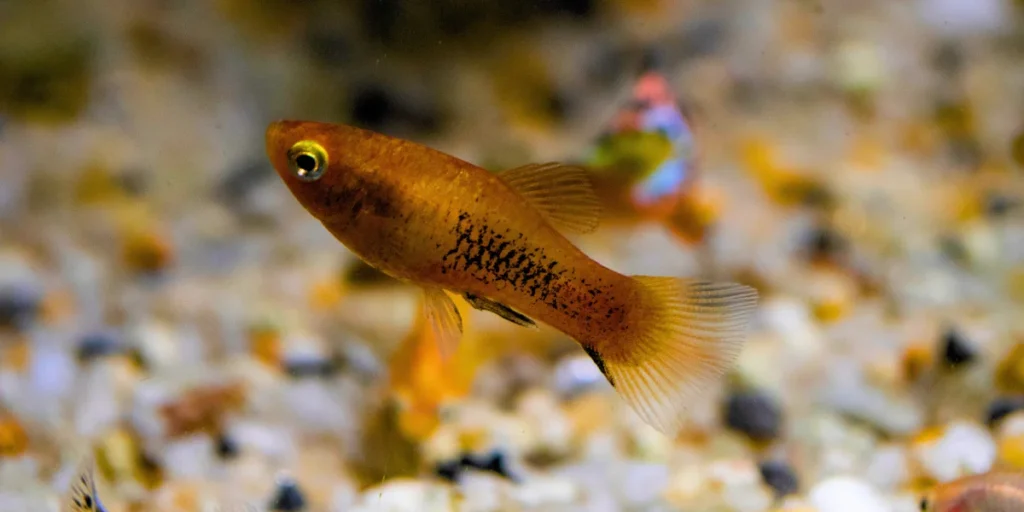
The Tuxedo Platy is a stunning freshwater aquarium fish that turns heads with its elegant black and silver color pattern, resembling a tiny fish dressed in a tuxedo. Its classy and eye catching look makes it a favorite among aquarium hobbyists and beginner fish keepers who love vibrant yet easy to care for fish.
These peaceful and playful Platies thrive in community tanks with other gentle, non aggressive fish such as guppies, mollies, and tetras. They love exploring their surroundings, especially in aquariums filled with plants, rocks, and hiding spots where they can swim freely and feel safe.
With clean water, a balanced diet, and regular care, Tuxedo Platies stay healthy and continue to show off their bold black and silver colors. If you’re looking for a low maintenance, colorful, and friendly fish to add charm and elegance to your tank, the Tuxedo Platy is a perfect choice.
What is a Platy Fish?
The Platy fish (Xiphophorus maculatus) is a small and colorful freshwater fish that originally comes from Central America. Loved by aquarium enthusiasts around the world, these bright little swimmers are known for their vibrant colors, playful personalities, and easy care. If you’re new to fishkeeping, Platies are one of the best beginner friendly aquarium fish you can choose. They’re peaceful, active, and full of life.
One of the best things about Platy fish is their stunning variety. You can find them in shades of red, orange, yellow, blue, and even black, with unique patterns like spots, stripes, and speckles. Their wide color range makes them a favorite for anyone who loves a visually striking aquarium.
Platies are peaceful community fish, meaning they usually get along well with other gentle species like guppies, mollies, and tetras. They don’t need a large tank, even a 10 to 20 gallon aquarium is enough, but they do love having plants and decorations to explore or hide behind. Watching them swim around with curiosity and energy is truly delightful.
Another reason hobbyists adore Platy fish is their hardy nature. They can easily adjust to different water conditions, making them more forgiving than many other tropical fish. Just keep their tank clean, feed them a balanced diet, and maintain stable temperatures usually between 70°F and 78°F (21°C to 26°C and they’ll thrive for several years.
With their bright colors, gentle temperament, and low maintenance care, Platy fish can transform your aquarium into a lively underwater world. Whether you’re just starting your fishkeeping journey or adding to your collection, these cheerful swimmers bring endless color, charm, and movement to your tank.
Appearance of Platy Fish
The Platy fish may be small, but it’s packed with color and charm! These little swimmers usually grow to about 2.5 inches long, making them the perfect size for both beginner and experienced aquarium owners. With their round, oval shaped bodies, they glide gracefully through the water, showing off a combination of beauty and energy that instantly brightens up any tank.
What really makes the Platy fish stand out is its vibrant appearance. You can find them in stunning shades of red, orange, yellow, blue, and black, and sometimes, a beautiful mix of these colors. Many Platies also feature unique patterns like spots, stripes, or gradients, giving each one a personality of its own. Some even shimmer with metallic or iridescent hues, sparkling under aquarium lights like tiny underwater gems.
Their fan shaped tails don’t just add to their elegant look; they also help the fish move smoothly and steer easily as they swim. Over the years, breeders have developed many Platy color varieties, such as Mickey Mouse Platies, Tuxedo Platies, and Sunset Platies, each with its own unique color combination and charm.
Because of their compact size and peaceful temperament, Platy fish are easy to care for and fit well in small aquariums or community tanks. Their playful movements and striking colors bring life and joy to any aquatic setup. Whether you’re new to fishkeeping or already have an established tank, these cheerful, low maintenance fish are guaranteed to make your aquarium shine.
Common Platy Colors and Patterns
| Color/Pattern | Description |
|---|---|
| Red | Bright red color, often with solid or slightly blended hues. |
| Orange | A vibrant orange shade, sometimes with a gradient effect. |
| Yellow | Shiny yellow, often seen in some Platies with metallic hues. |
| Blue | Blue Platies come in lighter shades or darker, deeper tones. |
| Black | Solid black or dark patterns that create contrast with lighter colors. |
| Spotted | Platies with a mix of colors in spots or dots on their body. |
| Striped | Long stripes running along the body, often in contrasting colors. |
| Multicolor | A blend of two or more colors, creating a unique and varied look. |
| Metallic | Shiny, reflective colors that shimmer in the light. |
Habitat of Platy Fish
The Platy fish originally come from the warm, slow moving rivers and streams of Central America, where they swim freely among lush aquatic plants, smooth rocks, and driftwood. In the wild, these peaceful fish love to explore, hide, and rest in shaded areas, so if you’re planning to keep them at home, it’s best to recreate a similar, cozy environment in your aquarium setup.
Ideal Tank Size for Platy Fish
If you’re keeping a small group of Platies (3 to 5 fish), a 10 gallon tank is the absolute minimum. However, for a larger group or a community tank that includes other friendly fish, go for a 20 gallon tank or more. Extra space helps your Platies swim comfortably and reduces stress, keeping them active and healthy.
Water Temperature for Platy Fish
Platy fish thrive in warm tropical water with temperatures between 70°F and 80°F (21°C to 27°C). If you live in a cooler climate, you might need an aquarium heater to maintain consistent warmth. Stable water temperature ensures your Platies stay energetic and display their best colors.
Water Quality and pH Level
Platies prefer slightly alkaline water, with a pH range of 7.0 to 8.0. To keep the tank clean and safe, install a good quality aquarium filter and change about 20 to 25% of the water weekly. This helps remove toxins like ammonia and nitrate, keeping your freshwater fish healthy and the water crystal clear.
Plants and Decorations for Platies
Platies love tanks filled with live plants, smooth rocks, and driftwood. These decorations not only make the aquarium look beautiful but also give your fish plenty of hiding spots to feel safe and relaxed. Live plants such as Java fern, Anubias, or Hornwort also help maintain better water quality by absorbing excess nutrients.
By providing the right tank size, warm temperature, clean water, and natural decorations, you’ll create the perfect environment for your Platy fish to thrive. In return, they’ll reward you with lively swimming, bright colors, and endless charm that make your aquarium come alive.
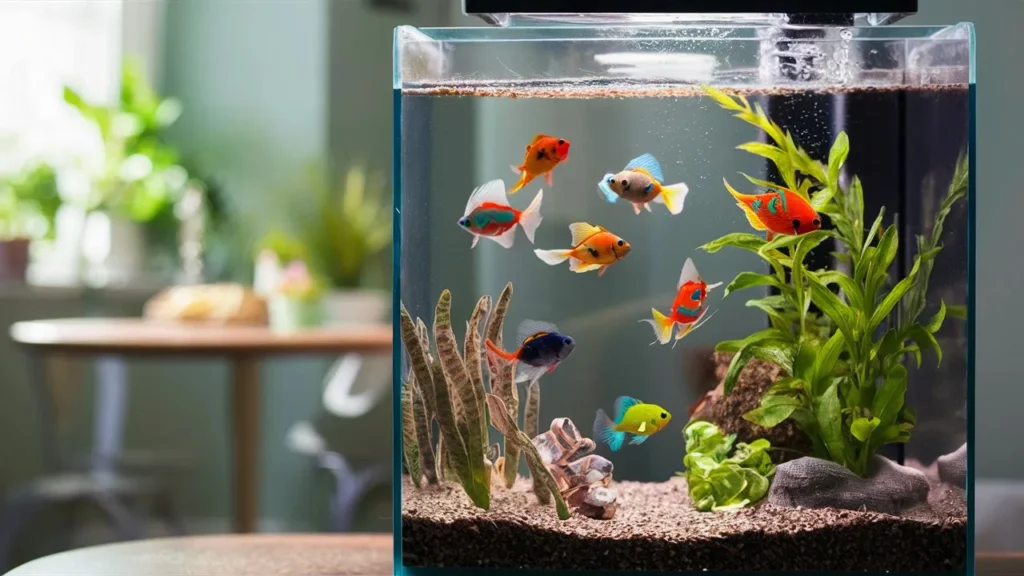
Setting Up the Tank
Creating a cozy and healthy home for your Platy fish is easier than you think! With the right setup, your Platies will swim happily, show off their bright colors, and stay healthy for years. Here’s a simple step by step guide to setting up the perfect Platy fish tank at home.
Clean the Tank Properly
Start by rinsing your aquarium tank with warm water only. Never use soap or household cleaners these can leave harmful residues that may hurt your fish. A clean tank provides a safe and fresh start for your freshwater aquarium fish.
Add the Right Substrate
Spread a layer of fine gravel or aquarium sand at the bottom of the tank. Gravel helps maintain good water flow, while sand gives the aquarium a natural look. If you plan to add live plants, keep the substrate around 2 to 3 inches deep so the roots can grow properly.
Install Essential Equipment
Heater:
Platy fish love warm tropical water. Use an aquarium heater to maintain a temperature between 70°F and 80°F (21°C to 27°C). Consistent warmth keeps them comfortable and active.
Filter:
A gentle aquarium filter is important for keeping the water clean and clear. Avoid strong currents. Platies prefer calm water where they can swim freely.
Lighting:
Add a soft aquarium light and keep it on for 8, 10 12 hours a day. This simulates natural daylight, keeps your fish active, and helps live plants grow.
Decorate the Tank
Make your tank feel like home! Add live plants, smooth rocks, and driftwood to create hiding spots and places for your Platies to explore. Plants such as Java Fern, Anubias, or Hornwort not only make the tank beautiful but also help maintain good water quality by absorbing excess nutrients.
Add Safe, Dechlorinated Water
Fill the aquarium with dechlorinated water. Tap water often contains chlorine or chloramine, which can harm your fish. Use a water conditioner to remove these chemicals before adding the water to the tank.
Cycle the Tank
Before adding your Platy fish, let the tank run for at least 7 days. This process, known as cycling, allows beneficial bacteria to grow, which helps keep ammonia and nitrite levels safe. Once the tank is fully cycled, your Platies can enjoy their new home without stress.
Creating a well balanced Platy fish aquarium setup ensures your fish stay happy, colorful, and full of life. With clean water, gentle lighting, and the right decorations, you’ll have a thriving aquatic world that’s as enjoyable for you as it is for your fish!
Maintaining the Tank
Once your Platy fish tank is set up, keeping it clean and healthy is the key to helping your fish live long, happy lives. With just a few simple steps, you can create the perfect environment for your Platies to thrive!
Water Changes
Change about 25% of the tank water every week. This helps remove waste, leftover food, and harmful toxins, keeping the aquarium water clean and safe for your fish. Regular water changes are one of the easiest ways to keep your Platy fish healthy and active.
Clean the Filter
Every 2 to 4 weeks, gently rinse the aquarium filter in a bucket of tank water (never use tap water it can kill the good bacteria that keep your tank balanced). A clean filter helps the water stay fresh and ensures your fish get the oxygen they need.
Test the Water
Use an aquarium water test kit to check these important levels:
- Ammonia: 0 ppm (should always be zero)
- Nitrites: 0 ppm (toxic even in small amounts)
- Nitrates: Below 20 ppm (higher levels can stress your fish)
If any of these are too high, do an extra water change right away to protect your fish.
Keep the Water Warm
Platy fish are tropical species that love warmth. Use an aquarium heater to maintain the temperature between 70°F and 80°F (21°C to 27°C). Check the temperature regularly with a tank thermometer to make sure it stays steady. Sudden changes can stress your fish.
Watch Your Fish’s Health
Healthy Platies are bright, energetic swimmers. If you notice dull colors, white spots, or your fish hiding more than usual, it may be a sign of illness or poor water quality. Early action, like adjusting water conditions or isolating sick fish, can prevent bigger problems.
Feeding Your Platies
Feed your fish 2 to 3 small meals a day using a mix of fish flakes, pellets, live food, or blanched vegetables like peas or spinach. Avoid overfeeding; only give what they can eat in 2 to 3 minutes. Remove uneaten food right after feeding to keep the water clean.
Choosing the Right Tank Mates
Platy fish are peaceful and love company! They get along well with friendly species like Guppies, Mollies, Tetras, and Cory Catfish. Avoid keeping them with large or aggressive fish such as Cichlids or Tiger Barbs, as they can stress or harm your Platies.
By following these easy steps, regular cleaning, proper feeding, and careful tank monitoring, you’ll create a beautiful, balanced environment where your Platy fish can live happily for years. A little weekly care goes a long way toward keeping your aquarium thriving and full of color!
Diet for Platy Fish
Platy fish are cheerful, colorful little swimmers that love to eat a variety of foods. They’re omnivores, which means they enjoy both plant and small animal foods. To keep your platy fish healthy, active, and full of energy, it’s important to give them a balanced diet that includes everything they need to grow and stay happy.
Everyday Foods (Staple Diet)
The main part of your platy’s diet should come from high quality fish flakes or pellets. These are packed with essential nutrients and are easy for platies to digest. A good staple food keeps its colors bright and its immune system strong.
Tasty Treats for Platies
Just like people love snacks, platies also enjoy an occasional treat! You can offer them frozen or live foods like brine shrimp, bloodworms, or daphnia. These are full of protein, which helps your fish grow faster and stay active. Think of these as their “power snacks” that boost health and happiness.
Healthy Veggies They’ll Love
Don’t forget to add some vegetables to their diet. Platies enjoy soft, blanched veggies like spinach, peas, or zucchini. To “blanch,” simply boil the veggies for a minute or two to make them tender and easier for your fish to nibble on. This adds fiber to their diet and keeps their digestive system running smoothly.
Feeding Tips for Happy, Healthy Platies
Feeding your platy fish the right way is just as important as what you feed them.
- Feed them 2 to 3 small meals a day.
- Give only as much food as they can finish in 2 to 3 minutes.
- Avoid overfeeding it can make your fish sick and dirty the tank water.
- Always remove leftover food after a few hours to keep the aquarium clean and safe.
By following these simple feeding habits, your platy fish will stay healthy, colorful, and full of life. A clean tank and a balanced diet are the secret ingredients to happy, long living platies!

How to Keep Your Platies Healthy
Your platy fish deserve the best care to stay healthy, colorful, and full of life. Luckily, it’s super easy to keep them happy once you know the basics. Follow these simple tips to make sure your aquarium platies live a long and stress free life.
Keep the Water Clean
Clean water means healthy fish! Try to change about 25% of the tank water every week. This helps remove waste and keeps the environment fresh. A good quality filter is also a must; it keeps the water clean and stops harmful toxins from building up.
If the water gets dirty, your platies can get sick quickly, so don’t skip your weekly clean up!
Test the Water Regularly
Your platies depend on balanced water conditions to thrive. Use a fish tank water test kit to check the pH, ammonia, nitrite, and nitrate levels at least once a week. You can easily find these kits at any pet or aquarium store.
If something looks off, like high ammonia or nitrate levels, fix it right away. You can do this by changing some of the water or using safe aquarium treatments. Keeping the water balance just right will make your platies more active and vibrant.
Watch Your Fish Closely
One of the best ways to spot trouble early is simply by watching your fish. If your platies start swimming oddly, hiding too much, or floating near the surface, it might mean something’s wrong.
Quick action is key! The sooner you notice and treat the problem, the faster your fish can recover. If you’re unsure what’s wrong, talk to a vet who specializes in fish or ask for advice from an experienced aquarium keeper.
Feed Them a Nutritious Diet
Good food equals happy fish! Feed your platies a mix of fish flakes, pellets, and occasional live or frozen foods like brine shrimp or daphnia. This variety gives them all the nutrients they need to stay healthy, strong, and colorful.
Just remember, don’t overfeed them. Offer only as much food as they can finish in 2 to 3 minutes, twice or three times a day.
Keep Them Stress Free
Fish can feel stress just like people, and stress can make them sick. Give your platies enough space to swim freely, and avoid overcrowding the aquarium. Sudden changes in water temperature or quality can also shock your fish, so always keep conditions stable.
A calm environment helps your platies stay relaxed, friendly, and full of energy.
A Little Love Goes a Long Way
Caring for platy fish isn’t hard, it’s actually fun! By keeping the tank clean, watching your fish daily, and feeding them the right foods, you’ll enjoy seeing your platies thrive for years.
If you ever notice signs of illness like clamped fins, loss of appetite, or unusual swimming, act fast and seek advice. With quick care and consistent attention, your platy fish will reward you with their cheerful presence and beautiful colors.
FAQs
1. Do Platies Breed Easily?
Yes, Platies breed quite easily. They are livebearers, meaning they give birth to live young instead of laying eggs. A female Platy can give birth to a batch of babies every 4 to 6 weeks if there is a male in the tank. It’s important to note that Platies breed often, so you may end up with many baby fish if you have both males and females.
2. Which is Better, Molly or Platy?
Both Molly fish and Platies are great aquarium choices, but it depends on your preferences:
- Platies are smaller, usually around 2.5 inches, and are peaceful, colorful, and easy to care for. They are better for beginners.
- Mollies can grow larger (up to 4 to 5 inches) and are also peaceful. They need slightly more care, especially when it comes to water conditions, as they prefer slightly brackish water (water with a bit of salt).
If you’re a beginner and want a colorful, smaller fish that’s easy to care for, Platies might be better for you. If you want slightly larger fish and don’t mind managing water conditions, Mollies can be a good choice.
3. How Many Platies Should Be Kept Together?
Platies are social fish and prefer to live in groups. It’s best to keep at least 3 to 5 Platies together so they feel comfortable and happy. If you have more space, you can keep more. Just make sure you have enough room in the tank and avoid overcrowding.
4. Can Platies Live in Cold Water?
No, Platies prefer warm water. The ideal water temperature for Platies is between 70°F and 80°F (21°C and 27°C). If the water gets too cold, they may become stressed and more likely to get sick. If you live in a colder area, you’ll need a heater in the tank to keep the water at the right temperature for them.
Conclusion:
Platies are colorful, peaceful, and easy to care for fish that make a wonderful addition to any aquarium, especially for beginners. With their bright colors and unique patterns, these little swimmers instantly bring life and beauty to your tank. Platy fish are friendly and social creatures that thrive in groups, so it’s best to keep at least 3 to 5 together. They love warm, clean water and need a balanced diet of flakes, pellets, and occasional treats like live food or vegetables to stay healthy and active. While platies breed easily, it’s important to keep an eye on the water quality and their overall environment to prevent common health problems.
With the right care and attention, your platy fish will live happily for years, showing off their vibrant colors and playful behavior. They’re truly one of the best choices for anyone looking to add a bright, low maintenance fish to their home aquarium.
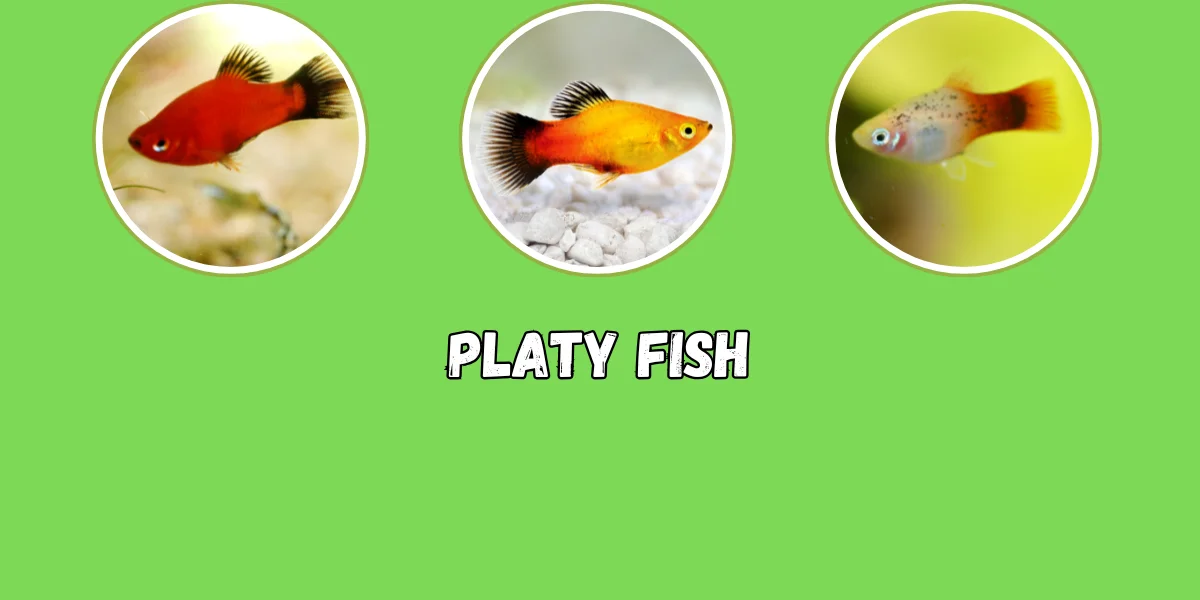
1 thought on “Complete Guide for Platy Fish Care: Types, Lifespan, Diet and Health”